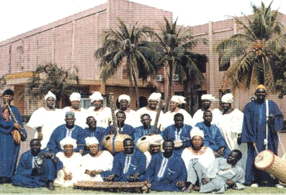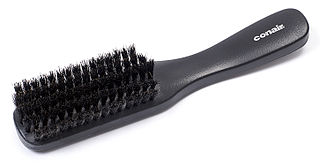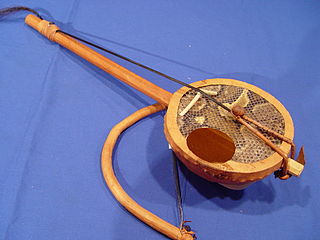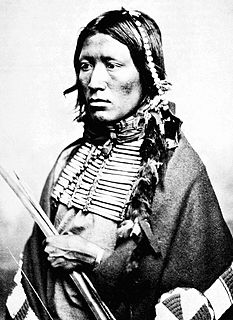
The Tuareg people are a large Berber ethnic group that principally inhabit the Sahara in a vast area stretching from far southwestern Libya to southern Algeria, Niger, Mali, and Burkina Faso. Traditionally nomadic pastoralists, small groups of Tuareg are also found in northern Nigeria.
In music, a bow is a tensioned stick which has hair coated in rosin affixed to it. It is moved across some part of a musical instrument to cause vibration, which the instrument emits as sound. The vast majority of bows are used with string instruments, such as the violin, viola, cello, and bass, although some bows are used with musical saws and other bowed idiophones.

The music of Mali is, like that of most African nations, ethnically diverse, but one influence predominates: that of the ancient Mali Empire of the Mandinka. Mande people make up around 50% of Mali's population; other ethnic groups include the Fula (17%), Gur-speakers 12%, Songhai people (6%), Tuareg and Moors (10%).

The morin khuur, also known as the horsehead fiddle, is a traditional Mongolian bowed stringed instrument. It is one of the most important musical instruments of the Mongol people, and is considered a symbol of the nation of Mongolia. The morin khuur is one of the Masterpieces of the Oral and Intangible Heritage of Humanity identified by UNESCO.

The erhu is a Chinese two-stringed bowed musical instrument, more specifically a spike fiddle, which may also be called a Southern Fiddle, and is sometimes known in the Western world as the Chinese violin or a Chinese two-stringed fiddle.

The music of Niger has developed from the musical traditions of a mix of ethnic groups; Hausa, the Zarma-Songhai, Tuareg, Fula Kanuri, Toubou, Diffa Arabs and Gurma and the Boudouma from Lac Chad.

A hairbrush is a handle brush with rigid or soft spokes used in hair care for smoothing, styling, and detangling human hair, or for grooming an animal's fur. It can also be used for styling in combination with a curling iron or hair dryer.
Various kinds of Arab music are popular in Libya such as Andalusi music, locally known as Ma'luf, Chabi and Arab classical music.
Amazigh music refers to the musical traditions of the Imazighen, an ethnic group native to the Maghreb, as well, as parts of the Sahara, Nile Valley, West Africa. Berber music varies widely across North-West Africa and some of the best known varieties can be found in Shilha music from Morocco; Kabyle, Chawi and Gasba music from Algeria; and Tuareg from Burkina Faso, Niger and Mali.
Bowed string instruments are a subcategory of string instruments that are played by a bow rubbing the strings. The bow rubbing the string causes vibration which the instrument emits as sound.
The music of Central Asia is as vast and unique as the many cultures and peoples who inhabit the region. Principal instrument types are two- or three-stringed lutes, the necks either fretted or fretless; fiddles made of horsehair; flutes, mostly open at both ends and either end-blown or side-blown; and jew harps, mostly metal. Percussion instruments include frame drums, tambourines, and kettledrums. Instrumental polyphony is achieved primarily by lutes and fiddles.

Horsehair is the long hair growing on the manes and tails of horses. It is used for various purposes, including upholstery, brushes, the bows of musical instruments, a hard-wearing fabric called haircloth, and for horsehair plaster, a wallcovering material formerly used in the construction industry and now found only in older buildings.

The goje is one of the many names for a variety of one or two-stringed fiddles from West Africa, almost exclusively played by ethnic groups inhabiting the Sahel and Sudan sparsely vegetated grassland belts leading to the Sahara. Snakeskin or lizard skin covers a gourd bowl, and a horsehair string is suspended on bridge. The goje is played with a bowstring.

A hair drop is an ornament worn by men from Great Lakes and Plains tribes. It would be tied to the man's hair. The typical example consists of a quilled or beaded section on a strip of leather, which was later attached to an American buffalo tail. They could be over two feet long.
The Berber Latin alphabet is the version of the Latin alphabet used to write the Berber languages. It was adopted in the 19th century, using varieties of letters.
The harp is the national instrument of Wales, with an unbroken line of harpers reaching back to at least the 11th century. Little is known of the origins of these early instruments, although small details such as poems are recorded, decrying the use of the new-fangled gut strings, as opposed to the traditional strings of plaited horse hair.
Ahardin is a musical bow played by southern Tuaregs consists of a curved branch held with a twisted rope of raw leather or bark of acacia. Serving as a sound box, a reversed calabash is placed on the curved part of the bow on the ground. To hold the whole, the player presses her knee on the container. With the fingers of the left hand, as with the imzad, she defines the melody, while with the thumb and forefinger of the right hand, she grip the string with a regular gesture vibrate. At present, the ahardin, an instrument whose manufacture is easily improvised, is considered above all as a game of girls.
The tende is a drum made out of a mortar, and the music associated with it, among the Tuareg people. It is constructed using a mortar with a drumhead made from goatskin stretched over it, with tension applied to the drumhead by way of two long wooden pestles. On either end the skin is rolled around the two pestles, and then stretched over the mortar and fastened with a rope. Frequently the pestles are kept in place; they can serve to tighten the skin and thus tune the instrument. The skin needs to be moistened periodically; sometimes water is simply applied during the performance, but another method is to keep water in the mortar and moisten the skin from the inside by tilting the instrument.
Darshanam Mogilaiah also known as Kinnera Mogulaiah is an artist from the Indian state of Telangana and is one among a few surviving performers of a tribal musical instrument known by the name kinnera. The kinnera is a stringed instrument much like a veena whose origin can be traced back to as early as the 4th century CE. The instrument is indigenous to the nomadic tribes and the Dalit communities in the Deccan Plateau such as the Dakkali, Madiga and the Chenchu. There are kinneras with different numbers of stairs or steps. Mogilaiah's forefathers were pioneers in making and playing kinneras having different numbers of stairs. His father had made a nine-stair kinnera. Mogilaiah was the first person to create a 12-stair kinnera and he is the only artist who makes and plays the 12-step kinnera. In the year 2022, Govt of India honoured him with the Padma Shri award for his contributions as a kinnera musician.









